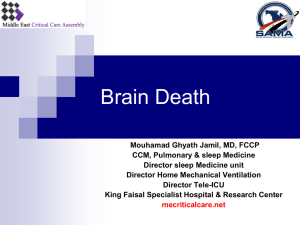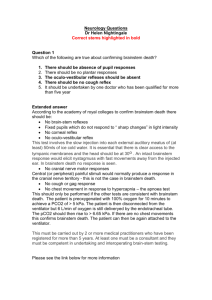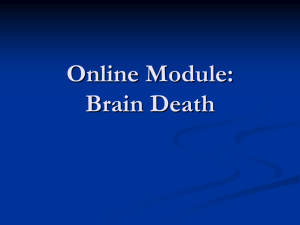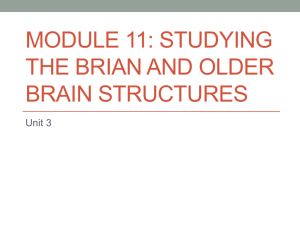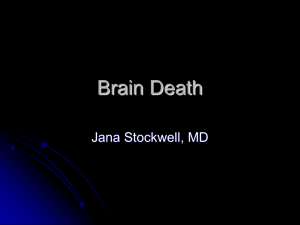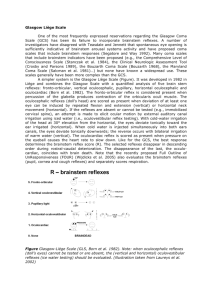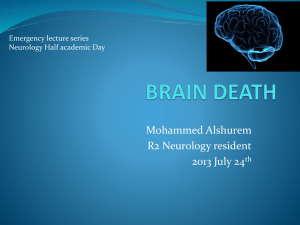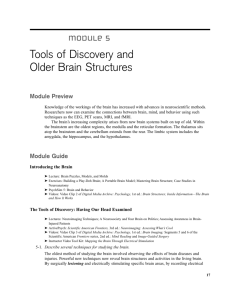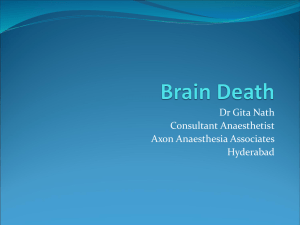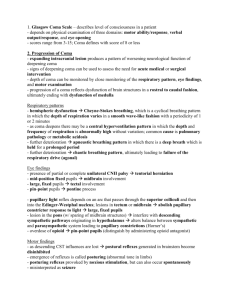Declaring Brain Death in the Low Resource ED
advertisement
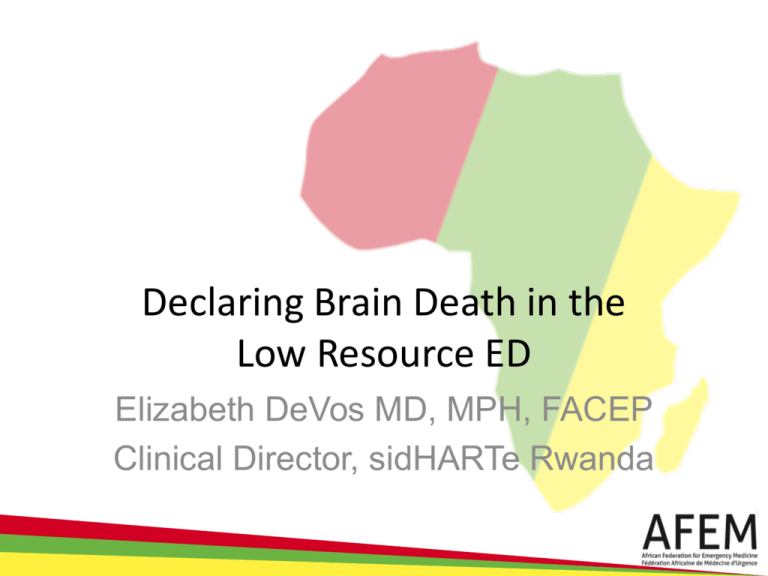
Declaring Brain Death in the Low Resource ED Elizabeth DeVos MD, MPH, FACEP Clinical Director, sidHARTe Rwanda Outline • • • • • History & Background Preconditions Clinical Testing Requirements Additional Testing Options African Context History • 1968: Harvard Medical School, Dr. Beecher Chairman of committee to: – “identify the moment of death for patients maintained on mechanical support to reallocate expensive resources to the living as well as to inform families as to whether the relatives were alive or truly dead – “To identify dead people from whom vital organs ethically could be obtained for transplantation” • 22nd World Medical Assembly Essential Statement on Human Death • 1981: President’s Commission – Study biomedical ethical problems – Testimony from medical, theological and lay witnesses • Uniform Determination of Death Act – Accepted by most states by late 1980s http://commons.wikimedia.org/wiki/Category:Polio#mediaviewer/File:IronLung.jpg 3 Defining Brain Death • What it is • “Diagnosis and confirmation of death based on the irreversible cessation of functioning of the entire brain, including the brainstem” • What it is not • Something other than “regular death” • Persistent vegetative state • A concept to facilitate organ transplants Preconditions: • 1. Brain injury capable of causing irreversible cessation of brain function • 2. Absence of: – – – – Hemodynamic shock Drug intoxication Hypothermia Significant, reversible metabolic or electrolyte derangement • 3. Intact neuromuscular function (Not under neuromuscular blockade) 5 Preconditions for Testing Confounders to Testing Established Etiology for Coma Hypothermia Absence of Hemodynamic Shock CNS Depressing Drugs Absence of Reversible Etiologies to Explain Coma High Cervical Spine Injury Competent Health Professional Performing Clinical Exam Evidence of Acquired or Iatrogenic Neuromuscular Paralysis Severe Acid-Base, Electrolyte or Endocrine Abnormality Competent Health Professional Performing and Interpreting Ancillary Labs and Testing Shock 6 Example Observation Periods for Ventilated Patients >4 Hours Apneic coma after major neurosurgery Confirmed aneurysm with second in hospital SAH >6 Hours Head Injury (no secondary hematoma, shock or brain hypoxia) Spontaneous ICH (no secondary hypoxic injury) >24 Hours 50-100 Hours Brain Hypoxia (drowning, cardiac arrest, etc) Any of the above with suspicion of drug intoxication and lack of ability to screen Adapted from Pallis C, Harley DH. The ABC of brainstem death. 2nd ed. BMJ Publications, 1996 7 • • • • Clinical Testing Loss of consciousness No spontaneous movements (excluding spinal reflexes) No motor responses in cranial distribution No brainstem reflexes – No pupillary light reflex-pupils mid-position or greater (‘fixed dilated pupils’) – No corneal reflex – No gag/pharyngeal reflex – No cough/tracheal • Vestibulo-ocular (‘cold caloric’) test • Oculo-cephalic (‘dolls eye’) test • Loss of capacity to breathe 8 Apnea testing • Hypercarbia maximally stimulates respiratory centers in the brain. • Apneic oxygenation diffusion test is safe – Limited comparative evidence between tests – Without testing PaCO2 may not catch apnea due to post hyperventilation • Recommended to do after all other tests – Hypercarbia could decrease cerebral blood flow in potential brain death 9 Additional Testing • • • • • • isoelectric EEG absent brain blood flow absence of brain perfusion absence of cerebral metabolic activity absent brainstem evoked potentials after wave 1 evidence of tonsillar herniation by neuro-imaging As an adjunct to, not substitute for clinical determination • Use and extent of complementary testing may vary by jurisdiction 10 Most country guidelines are similar: • Unresponsive coma with an established etiology • Absence of reversible conditions • Absence of cortical or brainstem mediated motor responses • Absent brainstem reflexes • Loss of the capacity to breathe 11 Where there is variation How to do apnea testing Depressant Drugs Observation time Age-related criteria Required level of physician expertise How to address anoxic-ischemic brain death Effect of therapeutic hypothermia Confirmatory, supplemental or ancillary testing (EEG, brain blood flow testing) • Time of death • • • • • • • • 12 AAN 10 year literature after 1995 guideline • No reports of patients recovering neurologic function who met 1995 AAN practice parameter • No sufficient evidence for: – What is adequate observation period? – Comparative safety techniques for determining apnea – Utility of MRI/MRA 13 Reflex spinal movements • Complex, non-brain mediated motor and spontaneous movements and non-respiratory triggering of the ventilator may occur in patients who are brain dead • Can confuse and upset family and nontreating physicians • Up to 75% of patients approaching brain death – Finger jerk, muscle stretch – Spinal automatisms • “Lazarus sign” ‘flex arms and shoulders, lift arms, dystonic hand posturing, crossing of hands” – Case reports of low-frequency gasps with CPAP may be reflex motor activity • Use Supraorbital ridge pressure to avoid stimulation of local limb spinal reflex activity when assessing pain response 14 15 Brain Death Evaluation: AFEM Handbook • 2 providers, at least 1 senior • Prerequisites: – Absence of clinical brain function with potential cause known and demonstrated as irreversible – Clinical or neuroimaging evidence of CNS catastrophe – Exclusion of potentially reversible circulatory, metabolic, and endocrine causes of coma – No toxicological explanation (including iatrogenic) – Core temp >36 C (regional variation, may require active warming) – Apnea 16 Brain Death Evaluation: AFEM Handbook • Coma (unresponsiveness) – No cerebral motor pain response (supraorbital, nailbed) • No Brainstem Reflexes – Pupils (mid-dilated 4-9mm) – No response to bright light (CN II-III) – Ocular Movement • Doll’s eyes (occulocepthalic reflex) • Caloric testing (Occulovestibular ) – Facial Sensation and Motor • No corneal reflex • No jaw reflex – Pharyngeal/Tracheal Reflexes • No gag reflex • No cough to suctioning • Apnea for 6-24 hours 17 Doll’s Eyes (Occulocephalic Reflex) Normal eyes move opposite to head movement BUT remains neutral in death (CN III and VI) HEAD EYES 18 HEAD EYES COLD WATER TESTING (Vestibulo-Occular Test) NORMAL BRAIN DEATH 19 Apnea testing • Protocol important to avoid secondary hypoxic brain injury • Verify Temp >36C, SBP >90, euvolemia, PCO2 and PO2 • Attach pulse oximeter • Disconnect ventilator while giving 6 lpm through intratracheal catheter at the carina – Repeat blood gas at 5-8 min (or local guideline) – Some require 10 min and SBP >100 throughout • STOP TEST if hypotension or cardiac instability occurs • +: No respiratory movement and PaCO2>60 mmHg(or increases 20 mmHg in some areas) • -: Respiratory movement observed 20 What about confirmatory tests? • Cerebral Blood Flow – Absence of CBF is conclusive of brain death – Requires moving to radiology for sophisticated scans – Blood flow DOES NOT rule out brain death • EEG – Different local requirements – Can be confusing • Altered by hypothermia, drugs, etc • Possible to have absent cortical function, isoelectric EEG and still have brainstem function • Brainstem Auditory Evoked Responses – Requires intact auditory nerve and pt without previously existing brainstem dysfunction – Simple, accurate, inexpensive, but requires trained personnel and equipment – Negative test doesn’t diagnose death without cortex testing – Not sufficient alone 21 What about Africa? Country Law Apnea Guideline Test # MD Observation Confirmatory (hr) Test Egypt A A A A A Unknown Ghana A A A A A Unknown S. Africa P P PCO2 2 A Optional Tanzania A P A 1 A Mandatory Tunisia P P DVO 1 A Optional 22 Adapted from: Wijdicks EF, Brain Death Worldwide: Accepted Fact But No Global Consensus in Diagnostic Criteria. Neurology, 2002:58; 20-25. Wijdicks EF, Brain Death Worldwide: Accepted Fact But No Global Consensus in Diagnostic Criteria. Neurology, 2002:58; 20-25. • Recommendations – International task force could address inconsistencies in guidelines – Develop apnea test criteria • ie could do serial measurement of PCO2 at bedside – Consider reducing observation periods and confirming tests • Challenges – Cultural and religious barriers – Difficulty getting country buy in – Concern about errors and MD qualifications Summary • Brain death is the permanent loss of function of the entire brain, including brainstem • Clinical criteria can be used to identify brain death • Confirmatory tests can help in confusing situations • African EDs can add their experiences to the literature as we gather more information References • • • • • • • • • • 25 Dixon T and Malinoski D. Western J Emerg Med. 2009; 10 (1): 117 Guidelines for the determination of death: report of the medical consultants on the diagnosis of death to the President’s commission for the study of ethical problems in medicine and biochemical and behavioral research. JAMA 1981;246:2184 –2186. Laureys, S. Death, unconsciousness and the brain. Nature Reviews Neuroscience. Nov 2005; 6 (11): 899-909 Pallis C, Harley DH. The ABC of brainstem death. 2nd ed. BMJ Publications, 1996 Pike R, McCurdie F, Kahn D. Brainstem Death in the Intensive Care Unit. The Southern African Journal of Critical Care. 1992: 8(1); 8-11 Practice parameters for determining brain death in adults (summary statement). The Quality Standards Subcommittee of the American Academy of Neurology. Neurology. 1995;45 Shemie S et al. International Guideline Development for the Determination of Death. Intensive Care Med. 2014; 40: 788-797 Uniform Determination of Death Act, 12 uniform laws annotated 589 (West 1993 and West suppl 1997). Wijdicks EF, Brain Death Worldwide: Accepted Fact But No Global Consensus in Diagnostic Criteria. Neurology, 2002:58; 20-25. Wijdicks EF, Varelas, P, Gronseth G, and Greer D. Evidence-based guideline update: Determining brain death in adults. Neurology, 2010; 74:1911-1918.
